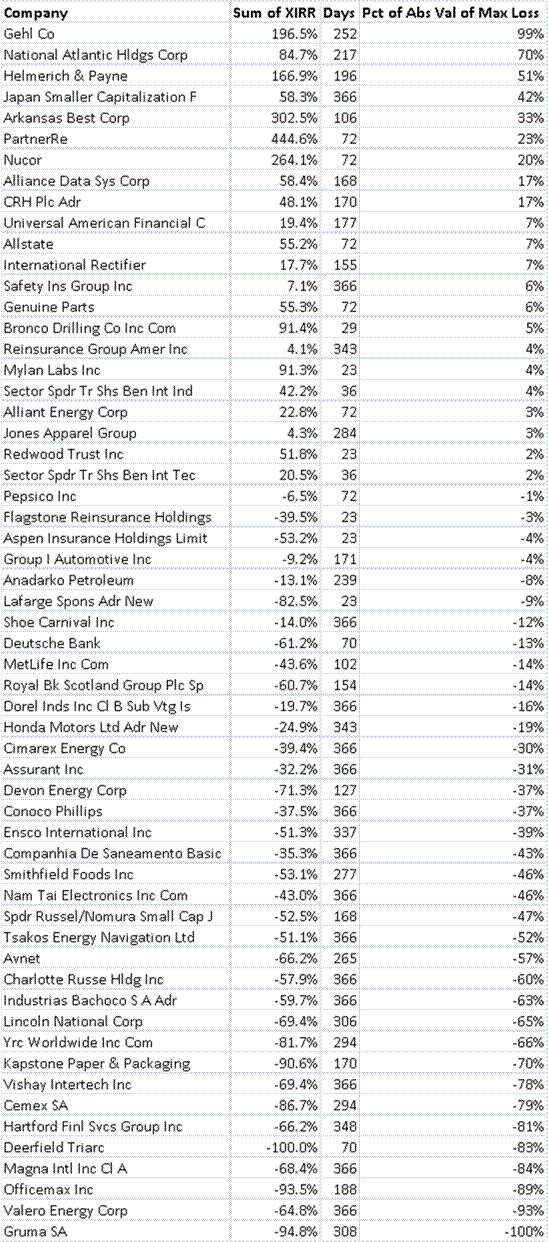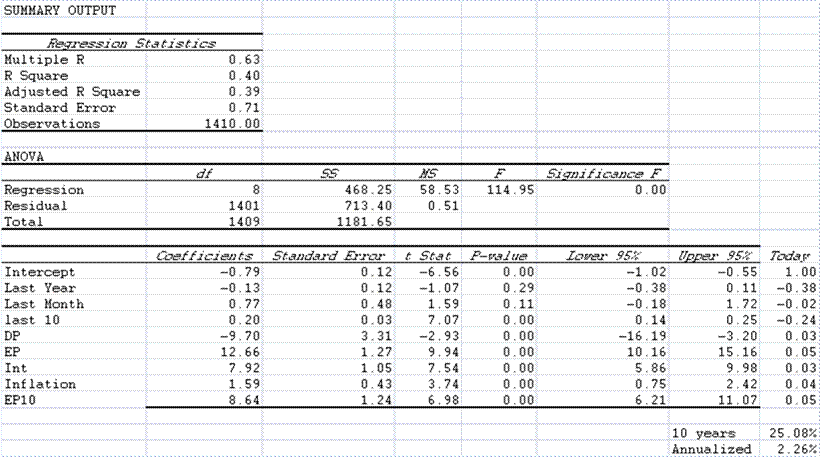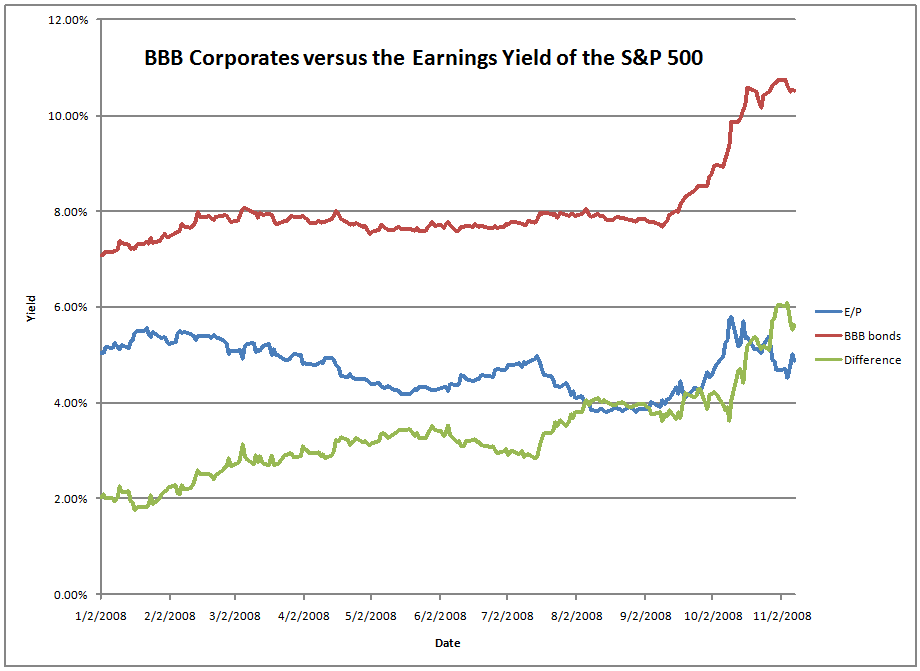Happy New Year to my Readers
At the beginning of each calendar year, I sit down and see how my expenses have tracked over the past year.? I make a table and a pie chart to show my wife.? She is always amazed at how much goes to taxes, though the new amazement is what it takes to put children through college.? We spend some time discussing plans for the next year.? Since my wife is not money-oriented (not a big spender, and focused on teaching the children) this gives her a quick way to get reoriented in our financial situation.
After that, I look at investment income.? 2008 was an unusual year for me in this way: it was the first year in my working life that my net worth fell.? Though painful, at age 48, I’m grateful that I have had a good past.
I then look at how individual stocks in the portfolio did.? Here’s a chart for 2008:
The chart is in order from the biggest gain to the biggest loss.? XIRR is the internal rate of return on funds during 2008, and days was the number of days I held a position during 2008.? Needless to say, this was my worst year ever, but I still did better than the S&P 500 by a middling single digit percentage.
That is important to me, because in 2009 I hope to gain my first external client. I have been banging my head against the wall, because I have a small bunch of investors that want to sign on, but they all don’t want to be my first client.? They want to see an institutional investor invest in my fund, then they will invest with me.? Frustrating.
Since strategy inception in 2000, I have beaten the S&P every year except 2007, where I missed by less than a percent.? And, given the performance of many well known value managers in 2008, beating the S&P ain’t bad.
Going back to the table above, I got whacked on names with bad balance sheets, life insurers, and names with too much cyclicality.? I did well on a number of names that I bought cheaply, and particularly on my October reshaping, where I focused on survivability.
I still think survivability is the watchword here.? I’ll be putting out my candidates list for the next reshaping soon, as well as my main industry model, but in an environment like this, raw cheapness doesn’t matter; a company must survive to realize the discount on its valuation.? Remember, the main rule of value investing is not “buy them cheap,” is not “lowest average cost wins,” but is “margin of safety.”
One more note: the present portfolio “long only” portfolio is 22% cash.? That is the highest level in eight years.? I have raised cash into the recent rally through my normal rebalancing discipline.? I will deploy cash as I get opportunity into strong names with strong balance sheets.
Asset Allocation
I also look at our asset allocation.? Excluding our house (no mortgage), it looks like this:
- 30% Cash and TIPS
- 20% International Stocks
- 18% Large Cap US Stocks
- 17% Small Cap US Stocks
- 15% Private Equity
I have no debts, but I have eight liabilities, two of which are going to college, and six of which might do so.? That is my main financial challenge for the next fifteen years (the little one is almost seven, and what a cutie.)
Even though I am bearish, I am comfortable with the amount of risk that I am taking, partly because I may derive a business from it through my ability to pick stocks that do relatively well.? The private equity is illiquid, but in this environment even it is doing well — having clever businessmen as friends is a help.
Recent Changes
Here’s a list of my moves since the last time I wrote:
Outright Sale — Gruma SA
Swap — Bought Japan Smaller Capitalization Fund, sold SPDR Russell Nomura Small Cap Japan? (The CEF was trading at an extreme discount)
Rebalancing Sales
- Assurant (3)
- RGA
- Valero Energy
- CRH
- Magna Automotive
- Safety Insurance
- Charlotte Russe
- Shoe Carnival
- Devon Energy
- Japan Smaller Capitalization Fund
Rebalancing Buys
- Assurant (2)
- Charlotte Russe (2)
- Magna Automotive
- Shoe Carnival
- Nam Tai Electronics
I also participated in the RGA exchange, where I traded my A shares for B shares when the discount was wide, and received RGA shares one-for-one when the exchange was complete.
Blog News
I have several book reviews coming, including one on Technical Analysis, and one on how wealthy people got that way.? I also have a panoply of other article ideas:
- How the lure of free money corrupts politicians
- Setting up mutual banks
- The risk of no significant change (not yes we can, but, why do we need to change?)
- Hidden correlations
- The mercantilists lost
- Analyzing TIPS
- Momentum strategies
- Buybacks
- Confidence means keeping assets inflated
- How securitization could aid resolution of our current crisis
It is a lot of fun writing this weblog.? I enjoy it a lot.? As I close this note, I would like to thank:
- Those that read the blog
- Those that comment here, and send me email (all of which I read, but I can’t answer all of it)
- Seeking Alpha
- Others that republish me
- Those that buy products at Amazon through my site
- Those that buy blogads at my site
- Other bloggers that give me good ideas
- And the firm that employs me, Finacorp, but bears no liability for my mutterings here.
2009 may prove to be a better year than 2008.? If that is not true, we will be rivaling the Great Depression.? That said, there are opportunities even in bad economic environments, and lts see if we can’t make the best of what we do get.? Here is to making the most of our opportunities in 2009.? May the LORD bless us all in our endeavors.
Full disclosure: long COP SBS DIIB.PK MGA IBA XEC VLO TNP JSC NTE VSH SAFT CHIC SCVL HIG RGA HMC ESV KPPC DVN ALL PRE CRH PEP GPC LNT NUE AIZ (yes, that is the complete current portfolio)





